Redox Changes during the Past 100 ka in the Deeper Eastern Arabian Sea: A Study Based on Trace Elements and Multivariate Statistical Analysis
Abstract
1. Introduction
2. Materials and Methods
3. Results
Trace Element Geochemistry
4. Discussion
4.1. Redox Changes Reflected in Trace Element Behaviour
4.2. Statistical Methods Used in Reconstructing Behaviour of Redox Sensitive Elements
5. Conclusions
- During the past 100 ka, bottom waters never became anoxic during the deposition of the sediments but became dysoxic to suboxic during the last glacial maximum (LGM) and MIS2. The changes in bottom water oxygenation are very well reflected in trace element content and their ratios.
- The application of multivariate statistics on trace elements indicates two factors: the cluster 1 elements (Co, Cu, Mn) enriched during oxic conditions and the cluster 2 elements (Cr, Mo, Ni, V) enriched during dysoxic to suboxic conditions. Cluster analysis results are consistent with the Pearson correlation method.
- Our results suggest that the oxygenation conditions in the deeper EAS during the past 100 ka are driven by variations in monsoon-controlled surface water productivity and changes in the flux of circumpolar deep water.
- The dysoxic to suboxic bottom water conditions developed at the core location during colder climates are very well matched with increased organic matter flux. The high glacial productivity and weakening of ventilation are very well reflected in trace element proxies.
- The major factor responsible for the accumulation of the organic material in the EAS during glacials was the high supply of organic matter to the core location due to increased surface water primary productivity driven by NEM and convective mixing. Dysoxic to suboxic bottom water conditions thus probably developed as a consequence of increased productivity, but the role of circumpolar deep water flux cannot be overruled.
Author Contributions
Funding
Data Availability Statement
Acknowledgments
Conflicts of Interest
References
- Bunzel, D.; Schmiedl, G.; Lindhorst, S.; Mackensen, A.; Reolid, J.; Romahn, S.; Betzler, C. A multi-proxy analysis of Late Quaternary Ocean and climate variability for the Maldives. Inner Sea. Clim. Past 2017, 13, 1791–1813. [Google Scholar] [CrossRef]
- Majumder, J.; Gupta, A.K.; Kumar, P.; Kuppusamy, M.; Nirmal, B. Late Quaternary variations in the Oxygen Minimum Zone linked to monsoon shifts as seen in the sediment of the outer continental shelf of the eastern Arabian Sea. Palaeogeogr. Palaeoclimatol. Palaeoecol. 2022, 591, 110891. [Google Scholar] [CrossRef]
- Schmiedl, G.; Leuschner, D.C. Oxygenation changes in the deep western Arabian Sea during the last 190,000 years: Productivity versus deep water circulation. Paleoceanography 2005, 20, PA2008. [Google Scholar] [CrossRef]
- Singh, A.D.; Holbourn, A.; Kuhnt, W. Editorial preface to special issue: Recent advances in Indian Ocean paleoceanography and paleoclimate. Palaeogeogr. Paleoclimatol. Paleoecol. 2023, 615, 111443. [Google Scholar] [CrossRef]
- Xiu, C.; Du, M.; Zhang, X.; Hua, S. Changes of marine productivity sedimentary environment recorded by biogenic components in the Antarctica Ross Sea since the last deglaciation. J. Ocean. Limnol. 2020, 38, 1746–1754. [Google Scholar] [CrossRef]
- Nath, B.N.; Bau, M.; Rao, B.R.; Rao Ch, M. Trace and rare earth elemental variation in Arabian Sea sediments through a transect across the oxygen minimum zone. Geochim. Cosmochim. Acta 1997, 61, 2375–2388. [Google Scholar] [CrossRef]
- Banakar, V.K.; Oba, T.; Chodankar, A.R.; Kuramoto, T.; Yamamoto, M.; Minagawa, M. Monsoon related changes in sea surface productivity and water column denitrification in the Eastern Arabian Sea during last glacial cycle. Mar. Geol. 2005, 219, 99–108. [Google Scholar] [CrossRef]
- Mir, I.A.; Pattan, J.N.; Matta, V.M.; Banakar, V.K. Variation of Paleo- productivity and Terrigenous Input in the Eastern Arabian Sea during the Past 100 ka. J. Geol. Soc. India 2013, 81, 647–654. [Google Scholar]
- Almogi-Labin, A.; Schmiedl, G.; Hemleben, C.; Siman-Tov, R.; Segl, M.; Meischner, D. The influence of the NE winter monsoon on productivity changes in the Gulf of Aden, NW Arabian Sea, during the last 530 ka as recorded by benthic foraminifera. Mar. Micropaleontol 2000, 40, 295–319. [Google Scholar] [CrossRef]
- Duplessy, J.C. Glacial to interglacial contrasts in the northern Indian Ocean. Nature 1982, 295, 494–498. [Google Scholar] [CrossRef]
- Reichart, G.J.; Lourens, L.J.; Zachariasse, W.J. Temporal variability in the northern Arabian Sea oxygen minimum zone (OMZ) during the last 225,000 years. Paleoceanography 1998, 13, 607–621. [Google Scholar] [CrossRef]
- Schulz, H.; von Rad, U.; Erlenkeuser, H. Correlation between Arabian Sea and Greenland climate oscillations of the past 110,000 years. Nature 1998, 393, 54–57. [Google Scholar] [CrossRef]
- Nambiar, R.; Bhushan, R.; Raj, H. Paleoredox conditions of bottom water in the northern Indian Ocean since 39 ka. Palaeogeogr. Palaeoclimatol. Palaeoecol. 2022, 586, 110766. [Google Scholar] [CrossRef]
- Den Dulk, M. Benthic foraminiferal response to Late Quaternary variations in surface water productivity and oxygenation in the northern Arabian Sea. Geol. Ultraiectina 2000, 188, 1–205. [Google Scholar]
- You, Y. Implications of the deep circulation and ventilation of the Indian Ocean on the renewal mechanism of North Atlantic Deep Water. J. Geophys. Res. 2000, 105, 23895–23926. [Google Scholar] [CrossRef]
- Duplessy, J.-C.; Shackleton, N.J.; Fairbanks, R.G.; Labeyrie, L.; Oppo, D.; Kallel, N. Deepwater source variations during the last climatic cycle and their impact on the global deepwater circulation. Paleoceanography 1988, 3, 343–360. [Google Scholar] [CrossRef]
- Rohling, E.J.; Zachariasse, W.J. Red Sea outflow during the last glacial maximum. Quat. Int. 1996, 31, 77–83. [Google Scholar] [CrossRef]
- Liu, Y.-G.; Miah, M.R.U.; Schmitt, R.A. Cerium: A chemical tracer for paleo-oceanic redox conditions. Geochim. Cosmochim. Acta 1988, 52, 1361–1371. [Google Scholar] [CrossRef]
- Schnetger, B.; Brumsack, H.J.; Schale, H.; Henrichs, J.; Dittert, L. Geochemical characteristics of deep-sea sediments from the Arabian Sea: A high resolution study. Deep-Sea Res. Part II 2000, 47, 2735–2768. [Google Scholar] [CrossRef]
- Hatch, J.R.; Leventhal, J.S. Relationship between inferred redox potential of the depositional environment and geochemistry of the Upper Pennsylvanian (Missourian) Stark Shale Member of the Dennis Limestone, Wabaunsee County, Kansas, U.S.A. Chem. Geol. 1992, 99, 65–82. [Google Scholar] [CrossRef]
- Wójcik-Tabol, P.; Oszczypko, N. Trace element geochemistry of the Early to Late Cretaceous deposits of the Grajcarek thrustsheets—A palaeoenvironmental approach (Małe Pieniny Mts., Pieniny Klippen Belt, Poland). Geol. Q. 2012, 56, 169–186. [Google Scholar]
- Zeng, S.; Wang, J.; Fu, X.; Chen, W.; Feng, X.; Wang, D.; Song, C.; Wang, Z. Geochemical characteristics, redox conditions, and organic matter accumulation of marine oil shale from the Changliang Mountain area, northern Tibet, China. Mar. Pet. Geol. 2015, 64, 203–221. [Google Scholar] [CrossRef]
- Zhao, Z.; Zhao, J.; Wang, H.; Liao, J.; Liu, C. Distribution characteristics and applications of trace elements in Junggar Basin. Nat. Gas Explor. Dev. 2007, 30, 30–33. [Google Scholar]
- Dean, W.E.; Gardner, J.V.; Piper, D.Z. Inorganic geochemical indicators of glacial-interglacial changes in productivity and anoxia on the California continental margin. Geochim. Cosmochim. Acta 1997, 61, 4507–4518. [Google Scholar] [CrossRef]
- Algeo, T.J.; Maynard, J.B. Trace-element behavior and redox facies in core shales of Upper Pennsylvanian Kansas-type cyclothems. Chem. Geol. 2004, 206, 289–318. [Google Scholar] [CrossRef]
- Kimura, H.; Watanabe, Y. Oceanic anoxia at the Precambrian–Cambrian boundary. Geology 2001, 29, 995–998. [Google Scholar] [CrossRef]
- Wagner, M.; Hendy, I.L. Trace metal evidence for a poorly ventilated glacial Southern Ocean. Quat. Sci. Rev. 2017, 170, 109–120. [Google Scholar] [CrossRef]
- Bonatti, E.; Fisher, D.E.; Joensuu, O.; Rydell, H.S. Postdepositional mobility of some transition elements, phosphorous, uranium and thorium in deep sea sediments. Geochim. Cosmochim. Acta 1971, 35, 189–201. [Google Scholar] [CrossRef]
- Crusius, J.; Calvert, S.E.; Pedersen, T.F.; Sage, D. Rhenium and molybdenum enrichments in sediments as indicators of oxic, suboxic and anoxic conditions of deposition. Earth Planet. Sci. Lett. 1996, 145, 65–78. [Google Scholar] [CrossRef]
- Pearson, T.H.; Tyson, R.V. (Eds.) Modern and ancient continental shelf anoxia. Geol. Soc. 1991, 58, 1–24. [Google Scholar] [CrossRef]
- Algeo, T.J.; Li, C. Redox classification and calibration of redox thresholds in sedimentary systems. Geochim. Et Cosmochim. Acta 2020, 287, 8–26. [Google Scholar] [CrossRef]
- Mir, I.A.; Mascarenhas, M.L.; Khare, N. Geochemistry and granulometry as indicators of paleoclimate, weathering, and provenance of sediments for the past 100,000 years in the eastern Arabian Sea. J. Asian Earth Sci. 2022, 227, 105102. [Google Scholar] [CrossRef]
- Pattan, J.N.; Mir, I.A.; Parthiban, G.; Karapurkar, S.G.; Matta, V.M.; Naidu, P.D.; Naqvi, S.W.A. Coupling between suboxic condition in sediments of the western Bay of Bengal and southwest monsoon intensification: A geochemical study. Chem. Geol. 2013, 343, 55–66. [Google Scholar] [CrossRef]
- Pattan, J.N.; Parthiban, G.; Gupta, S.M.; Mir, I.A. Fe speciation and Fe/Al ratio in the sediments of south eastern Arabian Sea as an indicator of climate change. Quat. Int. 2012, 250, 19–26. [Google Scholar] [CrossRef]
- Pattan, J.N.; Pearce, N.J.G.; Mislankar, P.G. Constraints in using cerium anomaly of bulk sediments as an indicator of paleo bottom water redox environment: A case study from the Central Indian Ocean Basin. Chem. Geol. 2005, 221, 260–278. [Google Scholar] [CrossRef]
- Chodankar, A.R.; Banakar, V.K.; Oba, T. Past 100 ky surface salinity gradient response in the Eastern Arabian Sea to the summer monsoon variation recorded by δ18O of G. sacculifer. Glob. Planet Chang. 2005, 47, 135–142. [Google Scholar] [CrossRef]
- Chodankar, A.R. The Late-Pleistocene Sedimentation History in the Eastern Arabian Sea. Climate Weathering Productivity linkages. Ph. D. Thesis, Goa University, Goa, India, 2004. [Google Scholar]
- Yarincik, K.M.; Murray, R.W.; Lyons, T.W.; Peterson, L.C.; Haug, G.H. Oxygenation history of bottom waters in the Cariaco Basin, Venezuela, over the past 578,000 years: Results from redox-sensitive metals (Mo, V, Mn, and Fe). Paleoceanography 2000, 15, 593–604. [Google Scholar] [CrossRef]
- Lewan, M.D.; Maynard, J.B. Factors controlling enrichment of vanadium and nickel in the bitumen of organic sedimentary rocks. Geochim. Cosmochim. Acta 1982, 46, 2547–2560. [Google Scholar] [CrossRef]
- Calvert, S.E.; Pedersen, T.F.; Naidu, P.D.; von Stackelberg, U. On the organiccarbon maximum on the continental slope of the eastern Arabian Sea. J. Mar. Res. 1995, 53, 269–296. [Google Scholar] [CrossRef]
- Calvert, S.E.; Pedersen, T.F. Sedimentary geochemistry of manganese: Implications for the environment of formation of Manganiferous Black Shales. Econ. Geol. 1996, 91, 36–47. [Google Scholar] [CrossRef]
- Nair, A.M.; Mathai, T. Geochemical Trends in Some Laterite Profiles of North Kerala, International Seminal on Lateralization Processes. Lateralisation Processes; Oxford and IBH Publishing Co.: Trivandrum, India, 1979; pp. 114–119. [Google Scholar]
- Calvert, S.E.; Bustin, R.M.; Pedersen, T.F. Lack of evidence for enhanced preservation of sedimentary organic matter in the oxygen minimum of the Gulf of California. Geology 1992, 20, 757–760. [Google Scholar] [CrossRef]
- Calvert, S.E.; Pedersen, T.F. Geochemistry of Recent oxic and anoxic marine sediments: Implications for the geological record. Mar. Geol. 1993, 113, 67–88. [Google Scholar] [CrossRef]
- Tribovillard, N.; Riboulleau, A.; Lyons, T.; Baudin, F. Enhanced trapping of molybdenum by sulfurized organic matter of marine origin as recorded by various Mesozoic formations. Chem. Geol. 2004, 213, 385–401. [Google Scholar] [CrossRef]
- Jones, B.; Manning, D.A.C. Comparison of geochemical indices used for the interpretation of palaeoredox conditions in ancient mudstones. Chem. Geol. 1994, 111, 111–129. [Google Scholar] [CrossRef]
- Sirocko, F.; Schonberg, D.G.; Devey, C. Processes controlling trace element geochemistry of Arabian Sea sediments during the last 25,000 years. Glob. Planet. Chang. 2000, 26, 217–303. [Google Scholar] [CrossRef]
- von Rad, U.; Schaaf, M.; Michels, K.H.; Schulz, H.; Berger, W.H.; Sirocko, F. A 5000–yr record of climate change in varved sediments from the oxygen minimum zone off Pakistan, northeastern Arabian Sea. Quat. Res. 1999, 51, 39–53. [Google Scholar] [CrossRef]
- Nadiri, A.A.; Moghaddam, A.A.; Tsai, F.T.; Fijani, E. Hydrogeochemical analysis for Tasuj plain aquifer, Iran. J. Earth Syst. Sci. 2013, 122, 1091–1105. [Google Scholar] [CrossRef]
- Belkhiri, L.; Boudoukha, A.; Mouni, L.; Baouz, T. Multivariate statistical characterization of groundwater quality in Ain Azel plain, Algeria. Afr. J. Environ. Sci. Technol. 2010, 4, 526–534. [Google Scholar]
- Tebbens, L.A.; Veldkamp, A.; Kroonenberg, S.B. The impact of climate change on the bulk and clay geochemistry of fluvial residual channel infillings: The Late Weichselian and Early Holocene River Meuse sediments (The Netherlands). J. Quat. Sci. Publ. Quat. Res. Assoc. 1998, 13, 345–356. [Google Scholar] [CrossRef]
- Iwamori, H.; Yoshida, K.; Nakamura, H.; Kuwatani, T.; Hamada, M.; Haraguchi, S.; Ueki, K. Classification of geochemical data based on multivariate statistical analyses: Complementary roles of cluster, principal component, and independent component analyses. Geochem. Geophys. Geosyst. 2017, 18, 994–1012. [Google Scholar] [CrossRef]
- Reichart, G.J.; den Dulk, M.; Visser, H.J.; van der Weijden, C.H.; Zachariasse, W.J. A 225 kyr record of dust supply, paleoproductivity and the oxygen minimum zone from the Murray Ridge (northern Arabian Sea). Palaeogeogr. Palaeoclimatol. Palaeoecol. 1997, 134, 149–169. [Google Scholar] [CrossRef]
- Leuschner, D.C.; Sirocko, F. Orbital insolation forcing of the Indian monsoon—A motor for global climate changes? Palaeogeogr. Palaeoclimatol. Palaeoecol. 2003, 197, 83–95. [Google Scholar] [CrossRef]
- Wang, Z.; Fu, X.; Feng, X.; Song, C.; Wang, D.; Chen, W.; Zeng, S. Geochemical features of the black shales from the Wuyu Basin, southern Tibet: Implications for palaeoenvironment and palaeoclimate. Geol. J. 2017, 52, 282–297. [Google Scholar] [CrossRef]
- Schulte, S.; Rostek, F.; Bard, E.; Rullkotter, J.; Marchal, O. Variations of oxygen minimum and primary productivity recorded in sediments of the Arabian Sea. Earth Planet. Sci. Lett. 1999, 173, 205–221. [Google Scholar] [CrossRef]
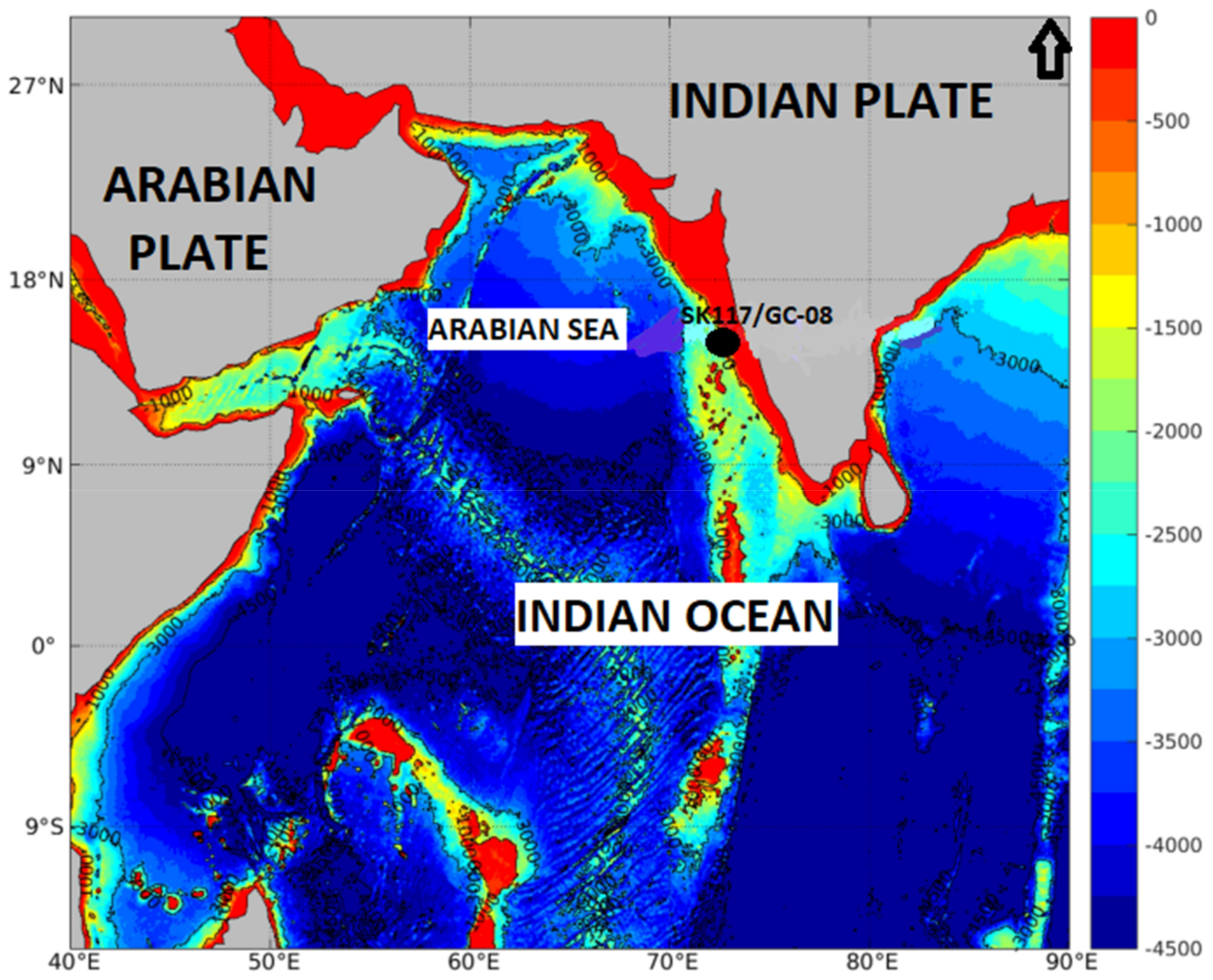
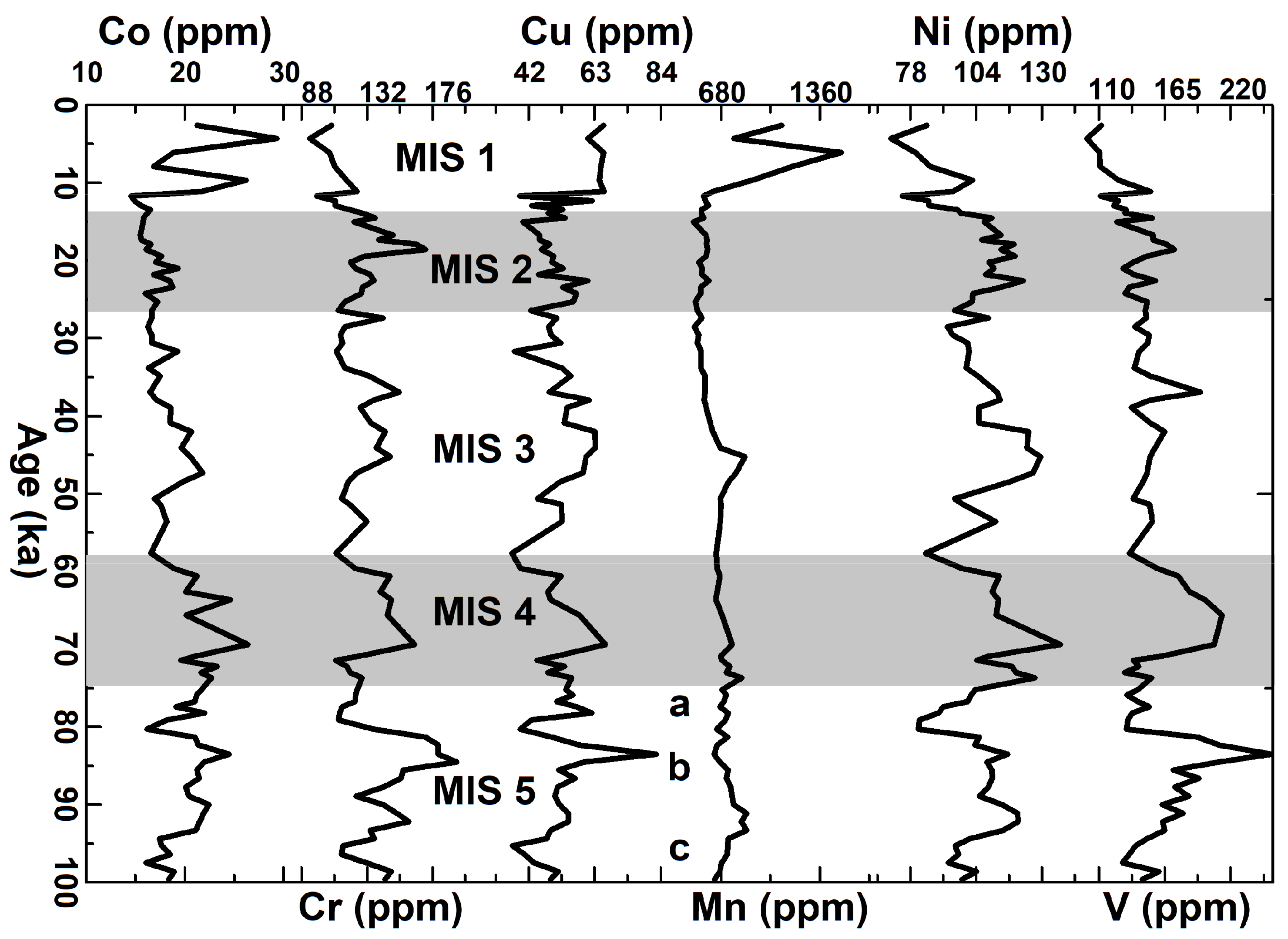
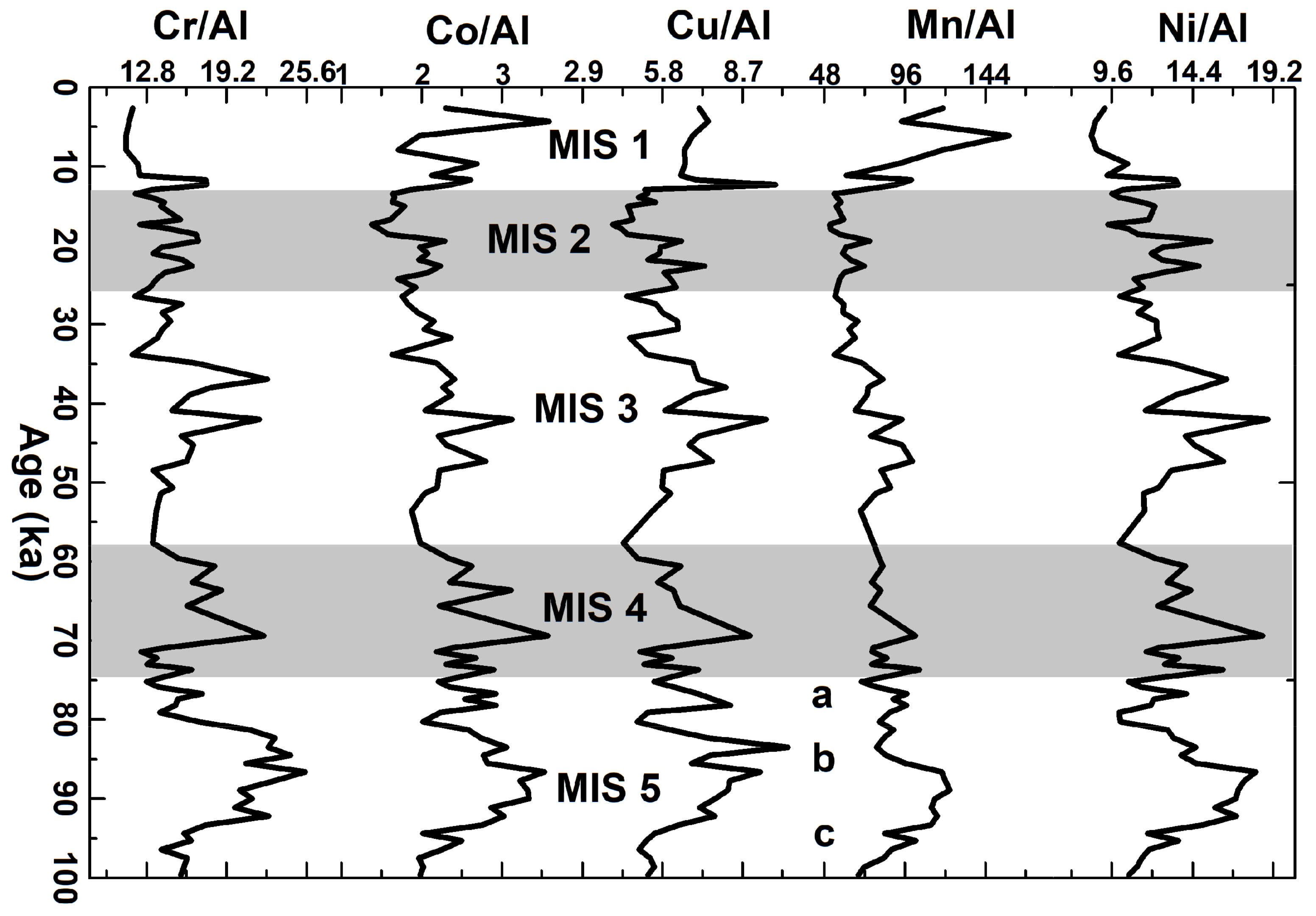

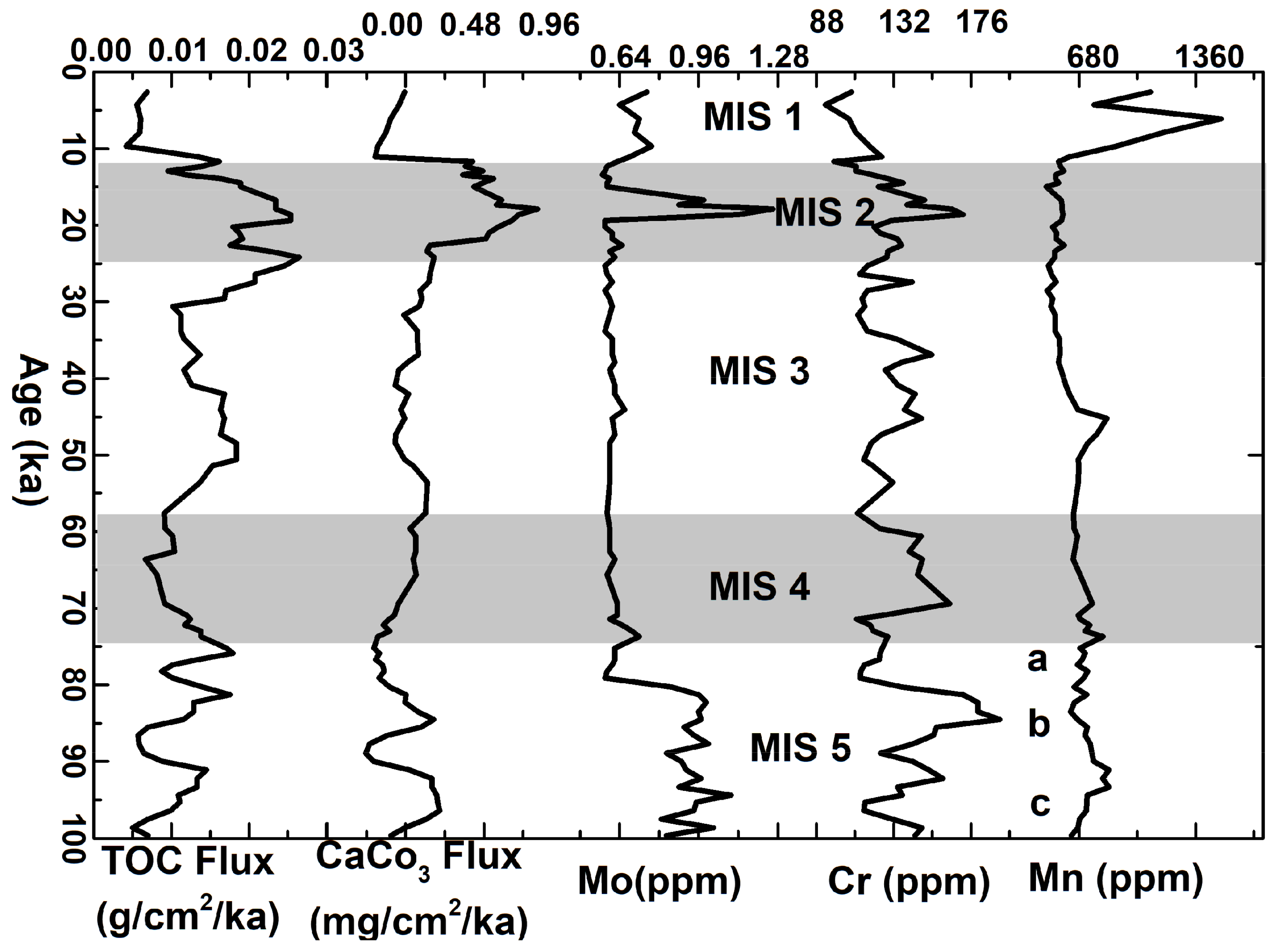
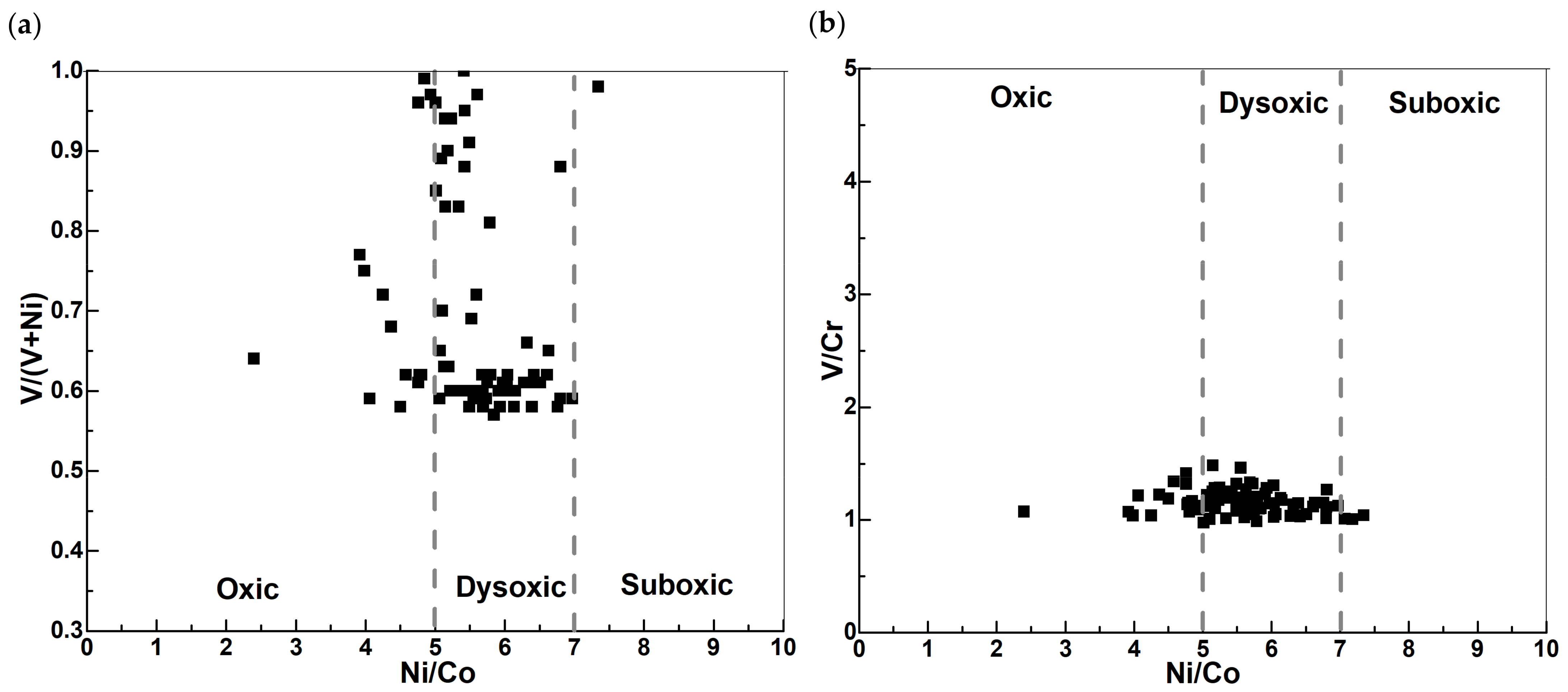
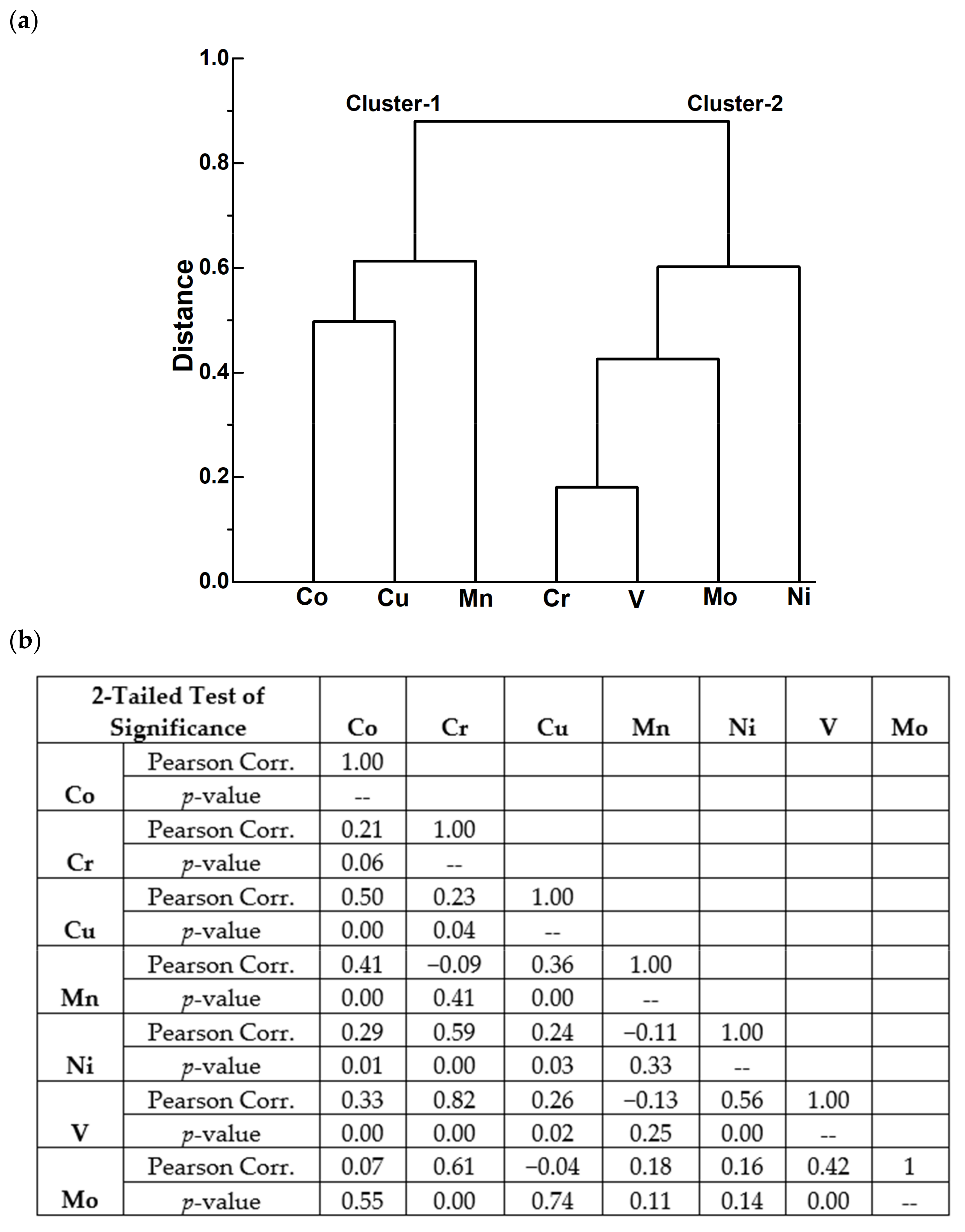
Disclaimer/Publisher’s Note: The statements, opinions and data contained in all publications are solely those of the individual author(s) and contributor(s) and not of MDPI and/or the editor(s). MDPI and/or the editor(s) disclaim responsibility for any injury to people or property resulting from any ideas, methods, instructions or products referred to in the content. |
© 2023 by the authors. Licensee MDPI, Basel, Switzerland. This article is an open access article distributed under the terms and conditions of the Creative Commons Attribution (CC BY) license (https://creativecommons.org/licenses/by/4.0/).
Share and Cite
Mir, I.A.; Luzia Mascarenhas, M.B. Redox Changes during the Past 100 ka in the Deeper Eastern Arabian Sea: A Study Based on Trace Elements and Multivariate Statistical Analysis. Water 2023, 15, 1252. https://doi.org/10.3390/w15071252
Mir IA, Luzia Mascarenhas MB. Redox Changes during the Past 100 ka in the Deeper Eastern Arabian Sea: A Study Based on Trace Elements and Multivariate Statistical Analysis. Water. 2023; 15(7):1252. https://doi.org/10.3390/w15071252
Chicago/Turabian StyleMir, Ishfaq Ahmad, and Maria Brenda Luzia Mascarenhas. 2023. "Redox Changes during the Past 100 ka in the Deeper Eastern Arabian Sea: A Study Based on Trace Elements and Multivariate Statistical Analysis" Water 15, no. 7: 1252. https://doi.org/10.3390/w15071252
APA StyleMir, I. A., & Luzia Mascarenhas, M. B. (2023). Redox Changes during the Past 100 ka in the Deeper Eastern Arabian Sea: A Study Based on Trace Elements and Multivariate Statistical Analysis. Water, 15(7), 1252. https://doi.org/10.3390/w15071252





